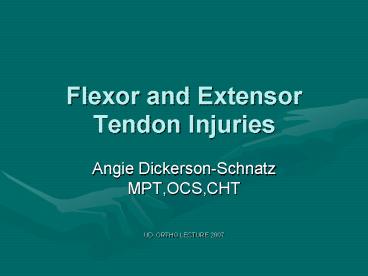Flexor and Extensor Tendon Injuries - PowerPoint PPT Presentation
1 / 40
Title:
Flexor and Extensor Tendon Injuries
Description:
Begin specific tendon gliding exercise. Begin gentle blocking exercise. DIP blocking exercises ... Promote tendon gliding if active digital flexion lacking ... – PowerPoint PPT presentation
Number of Views:3127
Avg rating:3.0/5.0
Title: Flexor and Extensor Tendon Injuries
1
Flexor and Extensor Tendon Injuries
- Angie Dickerson-Schnatz MPT,OCS,CHT
- UD ORTHO LECTURE 2007
2
Flexor tendon zones
- What are the contents of each zone?
- Zone I
- Zone II
- Zone III
- Zone IV
- Zone V
3
Flexor tendon anatomy
- FDP
- FDS
4
Flexor tendon sheath
- Its all about gliding
- House FDS and FDP
- Synovial lining
- Reinforced by pulleys
- A2, A4 loss reduces efficiency
- Lose lots of ROM
5
Incisions for flexor tendon repair
- Zigzag
- Increases exposure
- Decreases contracture
6
Flexor tendon repair
- Variety of suture techniques
- Strength of suture technique guides post-op rehab
progression
7
Goals following tendon repair
- Prevent rupture/gapping
- Promote wound healing
- Edema control
- Tendon gliding
- Prevent hypertrophic scar
- 80-90 TAM
- Return to functional grip
-
tenodesis rom
8
Prevent gap/rupture
- Protective splint
- 40yo CPA tuft fx c FDP LF
9
Prevent gap/rupture
- 40yo manual laborer, non-English speaking
10
Prevent gap/rupture
- 40yo manual laborer, non-English speaking
- IF FDP/?FDS repair, ?fracture
11
Progression of therapy based on tensile strength
- Protective phase (0-4.5 w)
- passive flexion/active extension
- 200-500 grams tensile strength across repair
- poor splint position
12
Progression of therapy based on tensile strength
- Protective phase/ Early stage (0-4.5 w)
- passive flexion/active extension
- 200-500 grams tensile strength across repair
- Motion phase/ Intermediate stage (4.5-8 w)
- Light composite grip
- 1500 grams
- Strengthening/ Late stage(8-12 w)
- maximum composite grip
- 5000 grams
13
Goals Protective phase 0-4.5 w
- Prevent tendon rupture
- Restore full passive digit flexion
- Prevent PIP flexion contracture
- Control edema
- Promote tendon excursion
14
Modified Duran protocol
- Splint
- MP flexion 40-50
- Wrist flexion 20-20
- IPS_at_ 0
- Passive flexion
- Passive extension
- Tenodesis
- poor splint
position
15
Post op Kleinert
- Splint
- MP flexion 40
- Wrist flexion 30-45
- Passive flexion
- Active PIP, IP extension within confines of
splint
16
Post op Kleinert
- Splint
- MP flexion 40
- Wrist flexion 30-45
- Passive flexion
- Active PIP, IP extension within confines of
splint
17
Early active motion
- With some repair techniques
- Check with physician
- Operational definition of early active motion
- place/hold
18
Kleinert Protective phase
- Passive flexion
- Assist to flex with elastic bands
- Wrist to neutral at 3 weeks
19
Active finger extension
- Block MPs dorsally to promote PIP extension
20
Motion phase at 4.5 weeks
21
Complications
- Fractures
- retraction
- time til repair
22
Complications
- Fractures
- retraction
- time til repair
23
Complications
- Fractures
- retraction
- time til repair
24
Tendon Gliding
- If tendon gliding is occurring freely, protect
longer - If tendon is adhered, motion attempts can be more
vigorous
25
Goals for motion phase
- Restore active flexion
- Reduce flexion contractures if present
- Protect against tendon rupture
26
Week 4.5 p.o.
- Place/hold
- Tenodesis
- Active finger flexion
- No blocking exercises yet.
27
Intermediate stage 3-6w
- Begin gentle active flexion
- Begin specific tendon gliding exercise
- Begin gentle blocking exercise
28
DIP blocking exercises
29
PIP blocking exercises
30
Goals for strengthening phase/ Late stage
- Promote tendon gliding if active digital flexion
lacking - Use of hand for ADL and work activities
31
Promote tendon glide
- Progressive resistance
32
Extensor Tendon Injury
- Zone I DIP
- Zone II middle phal
- Zone III PIP
- Zone IV prox phal
- Zone V MCP
33
Zone I Mallet fingerIntervention
- Non-operative
- closed injury
- Operative
- open injury
- More distal injury? longer protection
34
Zone I Mallet fingerIntervention
- Based on mechanism of injury
- Closed
- Splint in full extension
- Potential extension lag
- Splint 4-6 weeks, check
35
Zone I Mallet fingerIntervention
- Open
- ? Repair
- ? Infection
- Xray
36
Zone I after continuous immobilization
- Splint except for exercise
- 1 to 2 weeks
- Flexion of DIP
- Immobilize if extensor lag gt 15-20o
- Can use volar splint template to limit flexion
37
Extensor Tendon Injuries
- Splinted in Ext for other zones including joints
- 30yo installer, Zone V, Table
Saw
38
Extensor Tendon Injuries
- Splinted in Ext for other zones including joints
- outrigger style dynamic extension splint, used
39
Extensor Tendon Injuries
- Splinted in Ext for other zones including joints
- Progressive active flexion/passive ext to
protocol joint limitation/use template - progress flexion without ext lag
40
Extensor Tendon Injuries
- Example
- wrist 30 ext, MPs 0, PIP to 30 DIP to 25
- 2 weeks po, PIP to 40 etc.

